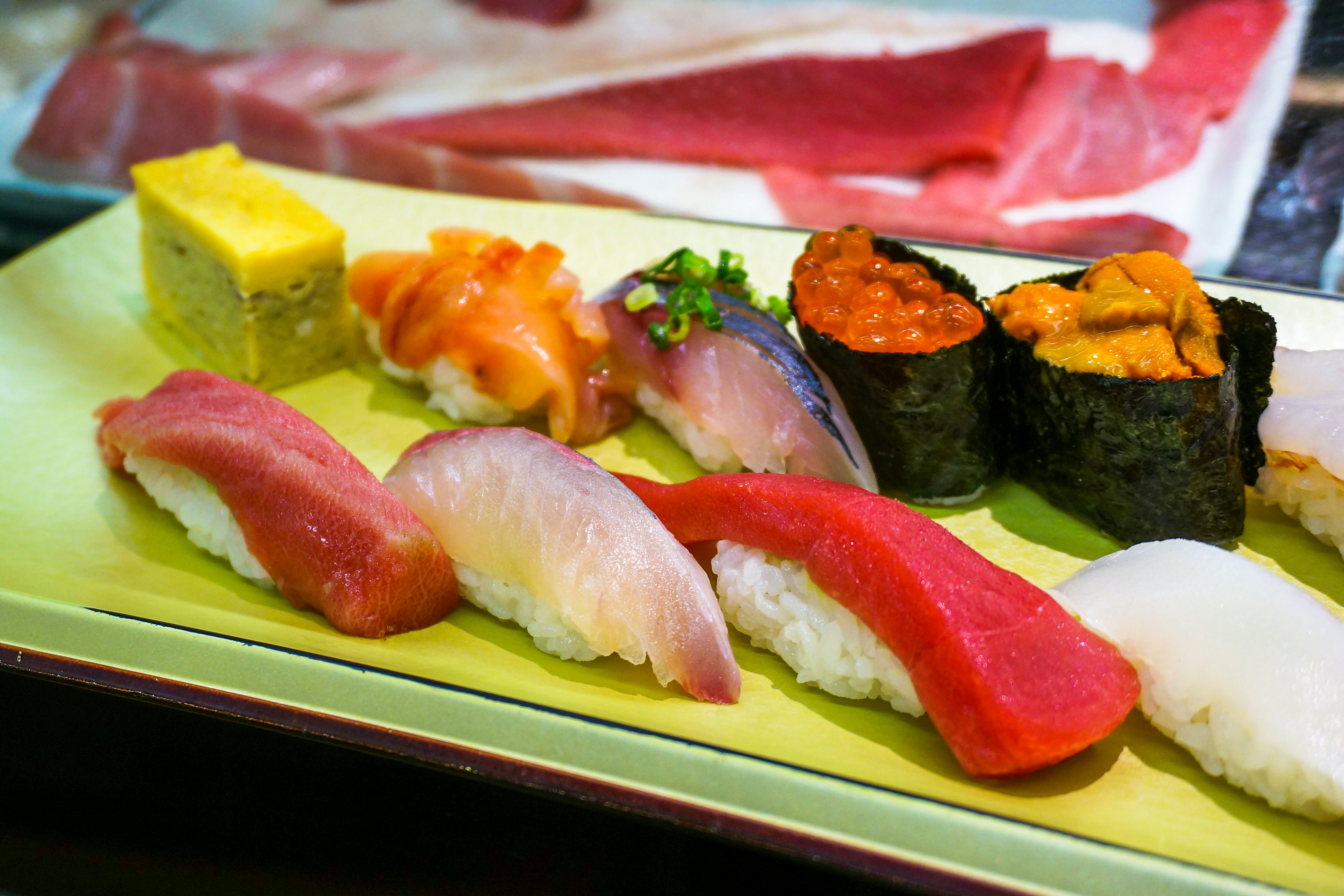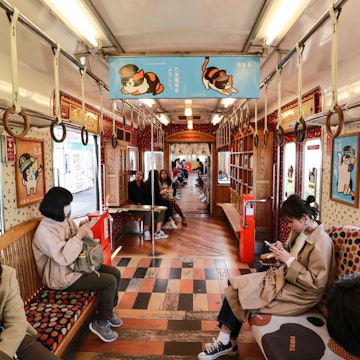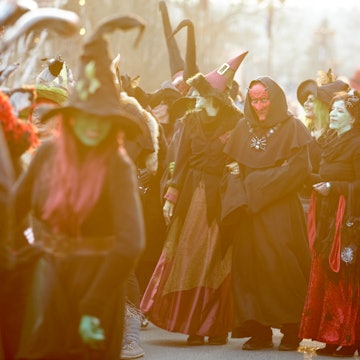

Nigiri-zushi and maki-zushi on a stand in Tokyo. Ruben Earth/Getty Images
Sushi is one of Japan’s most famous culinary exports and one of its most-consumed foods; that the salmon-and-tuna sushi has a permanent place in the emoji lexicon points to its importance in Japanese cuisine as well as food culture at large. Understand sushi's history, the etiquette to eating it, and the best places to try it in Tokyo with this guide.
History of sushi
Japanese sushi historians consider Southeast Asia to be the birthplace of the earliest form of sushi; while others note that the earliest references to sushi (flavored with orange peel and "wine" made from grains) appear in 6th-century China. Regardless, what we do know is that sushi first appeared in Japanese historical records during the 8th century as a luxury item, as tribute offerings to the court or as payment for skilled artisans.
Early sushi in Japan was made with lactic-acid fermentation, notably nare-zushi and funa-zushi. What we recognize as sushi today – nigiri-zushi, or hand-shaped vinegared rice topped with fish – dates back to the early 19th century in Edo (present-day Tokyo), when sushi became a popular street food eaten while standing. The early modern period saw a number of innovations: the development of "fast sushi" or "haya-zushi," in which sake, kōji, and vinegar were added to speed up fermentation; as well as the use of nori (seaweed) in commercially-made sushi from the latter half of the 18th century.
After WWII, sushi transformed from a cheap street snack into more of a sit-down meal. It was around this time that the term "Edomae" (literally "before Edo") became synonymous with nigiri-zushi. Kaiten-zushi – conveyor-belt sushi restaurants – began to pop up, offering inexpensive sushi by the plate. Today, sushi is consumed at a wide range of price points. Rarefied high-end establishments are for special occasions, but supermarket sushi and conveyor belt restaurants are ideal for quick, convenient meals.

Understanding Japanese sushi etiquette
There are a few pieces of etiquette to keep in mind, but eating sushi shouldn’t be a daunting experience. Enjoy your meal without worries with these pointers.
For starters, it’s entirely acceptable to use either your hands or chopsticks to eat at all sushi restaurants. When seasoning with soy sauce, dip the fish side of the sushi, not your rice! Rice soaks up soy sauce far too easily – it’ll be too salty and the whole piece will fall apart. Restaurants occasionally provide soy sauce brushes to prevent this issue. If you’re visiting a higher-end establishment for an omakase (chef's choice), each piece will already have been seasoned. There’s no need to add more soy sauce.
Other behavioral etiquette depends on the restaurant. High-end restaurants make more demands on the diner than more casual spots. The number one rule at these establishments, especially those with only a handful of counter seats, is to honor your reservation. At the very least, avoid no-shows and cancel early if needed – it’s considered rude to not show up at all.
It’s also best to avoid smoking beforehand or wearing strong perfumes, especially at more expensive sushi restaurants – this interferes with being able to taste the sushi, and is also unpleasant for other diners. Lastly, it’s impolite to leave a freshly-made piece in front of you for longer than a few seconds, so resist the temptation to photograph each piece of sushi. If in doubt, look to other diners for cues on how to behave.

Types of sushi you'll find in Tokyo
Nigiri-zushi: The quintessential "Edomae" Tokyo-style sushi consisting of hand-pressed rice, topped with fish or other seafood.
Maki-zushi: Rolled sushi with ingredients wrapped in seaweed and rice.
Temaki-zushi: Imagine an ice-cream cone, but with a nori cone filled with rice and raw fish. It's fun to eat!
Chirashi-zushi (scattered sushi): Essentially vinegared sushi rice with various toppings, most commonly different types of raw fish and thin slices of omelette.
Gunkan-maki: Nori wrapped around rice, with a mound of seafood on top. Named for its resemblance to a battleship, or "gunkan".
Most restaurants in Tokyo, particularly those offering omakase courses, tend to serve nigiri-zushi with one or two types of temaki- or maki-zushi. Chirashi-zushi is a popular lunch option. Kaiten-zushi restaurants offer most if not all of the above styles.
Mid-range and mass-market kaiten-zushi generally have a wide range of seafood on the menu; seasonal specialties will be highlighted. You will almost always see various types and cuts of tuna, salmon, squid, freshwater eel, conger eel, shrimp, mackerel, scallop and octopus. Seared wagyū (Japanese beef) sometimes appears as a sushi topping – gimmicky, yes, but tasty.
High-end establishments serve whatever is freshest and in season that day. A good indicator of a restaurant’s calibre is the quality of hikarimono (silver things) or blue-backed fish. Toppings like aji (horse mackerel), iwashi (sardine), sanma (pike mackerel) and kohada (gizzard shad) are utterly transformative in the hands of a skilled chef.
A note for salmon lovers: salmon is usually considered a low-quality, inferior topping at high-end Edomae-style establishments, and you’re unlikely to see it served there. Then again, overfishing has led to the likes of the once-common sanma (pike mackerel) becoming a sought-after fish. Who knows what we’ll see at high-end sushi shops in future?

Top sushi restaurants in Tokyo
Uobei, Shibuya
At Uobei, prices start at ¥110 (US$0.77) and hover around the ¥150 (US$1.05) mark per pair of nigiri, making this Shibuya kaiten-zushi restaurant the very definition of cheap and cheerful. The multilingual touchscreen menu has hundreds of choices – there are 11 nigiri variations for salmon alone – so it’s ideal for people who prefer choosing exactly what they want to eat. Families with young children, take note of the kids’ menu.
Practical info: 2-29-11 Dogenzaka, Shibuya, Tokyo; Mon–Fri, 11am–11pm; Sat-Sun, 10:30am–11pm
Pintokona, Roppongi Hills
Great cost-performance is the selling point of this basement sushi restaurant. Lunch sets start at ¥1480 (US$10.35), and while ¥480 (US$3.35) per piece of wild salmon nigiri might seem a little steep next to conveyor-belt sushi, the price is shockingly reasonable for the quality, freshness and portion size. It’s also family-friendly, and therefore a useful option to have in your back pocket.
Practical info: Metro Hat B2F, 6-4-1 Roppongi, Minato, Tokyo; 11am–3pm, 5–11pm, Sat and Sun 11am–11pm
Sushi Azabu, Azabudai Hills
While we’re discussing cost-performance, lunch at Sushi Azabu is good value for money. A 14-piece omakase set for ¥4800 (US$34) in Azabudai Hills, including its signature black sesame tofu? That’s a steal. Are there better sushi places in Tokyo? Yes, but those other restaurants aren’t in the same complex as the teamLab Borderless, making this a logistically sound choice for tourists in Tokyo.
Practical info: 3F Hills Tower Plaza, 1-3-1 Azabudai, Minato, Tokyo; 11am–4pm, 5:30–10pm

Manten Sushi Marunouchi
A favorite with locals and tourists alike, this restaurant serves close-to-high-end sushi at mid-range prices. It's raised its prices recently, but ¥4400 (US$31) for the lunch omakase and ¥8800 (US$62) for the dinner course continues to be excellent value for the quality of the offerings, which often includes abalone and sea urchin, and you’ll actually feel full afterwards. Reservations through TableCheck are necessary if you don’t want to spend two hours waiting in line.
Practical info: Marunouchi Brick Sq, 2-6-1 Marunouchi, Chiyoda-ku, Tokyo; 11am–3pm, 5–11pm
Sushi Kyubey, Ginza
Kyubey is one of Tokyo’s most famous high-end sushi institutions. With consistent quality, it’s fairly relaxed and tourist-friendly, making it a good choice for those trying high-end sushi for the first time. Walk-ins are often possible at lunch as the restaurant is unusually large for Tokyo – it has multiple floors, with the ground floor alone seating 14 at a counter.
Practical info: 8-7-6 Ginza, Chuo, Tokyo; 11:30am–2pm, 5–10pm (closed Sun and Mon)

Best areas for sushi in Tokyo
Some parts of Tokyo are better for sushi than others. Areas with high foot traffic from white-collar workers tend to have more in the way of good food, including sushi. Areas where business people entertain their clients will also have a higher concentration of high-end sushi establishments – glitzy neighborhoods like Ginza, Roppongi, and Azabu-Juban are prime examples.
For sushi on the mid to lower end of the price spectrum, the Tsukiji area is a solid bet, with at least a dozen sushi restaurants within five minutes' walking distance from the Outer Market (itself home to several decent if touristy sushi restaurants). Then there’s Toyosu Market. While it’s unabashedly tourist-oriented and accordingly overpriced, sheer proximity to the world’s freshest fish means that you’ll find sushi that’s anywhere from at least okay to sublime.
Unique sushi experiences in Tokyo
The beauty of sushi is that there are so many ways to experience it beyond the glamorous omakase. For a casual snack in the Edo fashion, head to a standing sushi bar for a few nigiri. Feeling peckish at midnight? Head to a 24-hour supermarket or convenience store and pick up some discounted sushi. Conveyor-belt sushi restaurants are fantastic for families or anyone who enjoys a bit of novelty – it’s just fun when your food whizzes straight to your table. If you’re a dab hand in the kitchen, you could even try a sushi-making class at a place like Tamasushi near Tsukiji Market.
The world of sushi is constantly evolving. One recent trend in the Tokyo scene is the "mellowing" of the shari (vinegared rice in nigiri-zushi). For several years, shari with a more acidic kick (thanks to the copious use of red vinegar) was popular among many restaurants, but appears to have become less so in the last two years.
Heavy use of social media, particularly TikTok, has also encouraged many restaurants to create more "Instagrammable" sushi with mass-market appeal – for example, fatty tuna sushi heavily loaded with sea urchin and salmon roe. Then there’s the colorful and divisive "sushi cakes" that resemble sponge cakes but aren’t, such as those made by No.Sushi. (These must be reserved before pickup in its Ginza shop.) Social media-friendly sushi is unlikely to go away, but consumers may become more discerning going forward.

How to order sushi like a local
Conveyor-belt sushi restaurants often have multilingual menus on touch-screen tablets. Other restaurants might have menus with photographs, while more old-fashioned ones might have handwritten menus or placards on the wall. But fish is fish wherever you go, and these days, Google Translate is able to handle much of the heavy lifting when it comes to communicating with Japanese speakers.
Here are a few phrases that should come in useful at any sushi restaurant:
xxx wa arimasu ka? – do you have xxx?
xxx, hitotsu kudasai – one xxx please
Sabi nuki kudasai – no wasabi, please
Shari sukuname kudasai – less rice, please
Okawari kudasai – one more of this item, please.
At a high-end sushi restaurant that serves omakase courses, you’ll need to specify what you do and don’t eat. For example, if you’re allergic to shellfish or you keep kosher, it’s up to you to inform the chef of your dietary requirements beforehand, either at the time of your reservation, or directly before the meal starts. You may wish to print out a translation of what you want to communicate and show this to the serving staff.
Practical tips for your sushi adventure
Planning is key to making the most of eating in Tokyo, especially if you want to squeeze in a few special sushi experiences. For popular establishments – especially high-end places – you’ll need to book at least 1–2 months in advance. Even a kaiten-zushi chain like Kura Sushi merits advance reservations online if we’re talking about the permanently-crowded Harajuku branch. On the extreme end of the spectrum, restaurants like Sushi Saito are introduction-only, meaning you’ll need magnanimous friends in the know to even get your foot in the door.
Sushi doesn’t have to break the bank. That being said, even conveyor-belt sushi can get expensive if you don’t keep an eye on the running total, so make sure you’re checking the e-tablet from time to time. If an omakase dinner at a high-end place feels a little too pricey, omakase lunches are an unbelievable steal. What it lacks in volume it makes up for in fabulous cost performance.
Modern interpretations of sushi
Sushi has become a global food, as we can see in the many ways it’s been interpreted around the world. Even within Japan, sushi innovation is ongoing. Besides No.Sushi’s aforementioned sushi cakes, there are now a small handful of restaurants in Tokyo that cater to vegetarians with plant-based sushi. For instance, the famed Udatsu in Nakameguro serves a gorgeous vegetarian set, which must be ordered at the time of reservation.
For a most unusual high-end sushi experience, try Sushi Sugahisa in Toranomon Hills, where Chef Kan Masahiro dishes up creative Thai-inspired versions of traditional sushi. Think cumin-spiced sauce on a piece of tuna nigiri, or savory egg custard infused with the flavors of green curry.
















